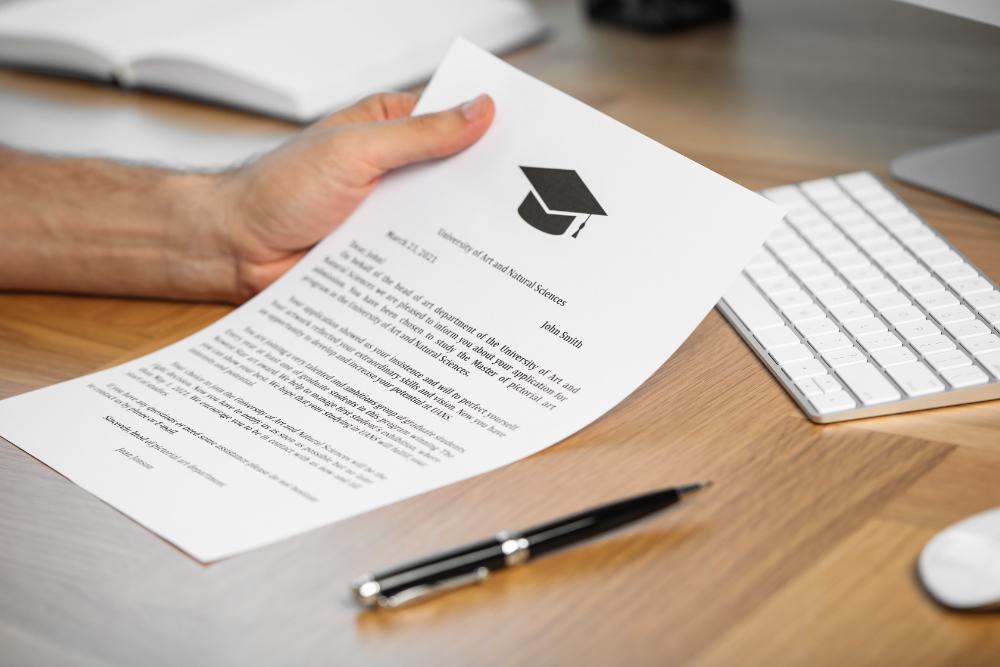Master's Letter of Recommendation: Writing Tips and Format
-
Letter of recommendation, Letter of recommendation sample

Table of Contents
Key Tips for Writing a LOR
Scroll here ↓What Should Be the Structure/Format of a LOR?
Scroll here ↓What are the Submission Methods for a LOR?
Scroll here ↓How to Request a Letter of Recommendation?
Scroll here ↓What is the Difference Between LOR, SOP, and Letter of Reference?
Scroll here ↓Who Should Write Your LOR?
Scroll here ↓Conclusion
Scroll here ↓Key Tips for Writing a LOR
- Highlight various accomplishments
Make sure the person recommending you discusses all of your accomplishments—academic standing, extracurricular involvement, and character attributes, among others. An inclusive letter of recommendation should highlight various aspects of your character and academic background.
- Provide Relevant Information to the Recommender
Even if the recommender is well-acquainted with you, they may not remember all your accomplishments. It's helpful to provide them with a comprehensive resume, including academic achievements, volunteer work, extracurricular activities, and any other relevant information. Sharing your GPA, awards, and submission deadlines is also useful to guide their writing.
- Use Specific Examples
A recommendation letter full of generic praise may not have the desired impact. Your recommender should provide specific anecdotes that demonstrate your qualities. Whether it's a classroom discussion, a research project, or a leadership role, examples rooted in personal experiences will resonate more strongly with the admissions committee.
- Showcase Improvement Over Time
Admissions officers receive numerous letters filled with unrelenting praise, which can sometimes seem unrealistic. To make your LOR more authentic, ensure the recommender mentions how you’ve grown over time, focusing on areas where you’ve capitalized on strengths and addressed weaknesses. Demonstrating improvement paints a realistic and more compelling picture.
- Avoid an Overly Dry Tone
While a recommendation letter is a formal document, it should not be too dry. Personalized, yet professional, letters are often appreciated by admissions officers. A well-written letter with a unique style that avoids clichés will stand out.
- Avoid Plagiarism
Plagiarism is a serious offense in academic settings, and admissions committees can easily detect copied content. Each letter should be original and specific to the student. Recommenders should avoid using generic templates and instead focus on providing a personalized letter for each candidate.
What Should Be the Structure/Format of a LOR?
The structure and format of the letter of recommendation for students are just as crucial as its content. A well-organized letter that clearly communicates the intended message can leave a strong impression. It should be divided into several paragraphs, each addressing different aspects of the student’s qualifications. Here’s a recommended structure:
1. First Section: Introduction
This part should lay the foundation for the relationship between the candidate and the recommender. It should clarify how the recommender knows the candidate and establish their qualifications to assess the candidate’s skills and capabilities. The stronger the connection between the recommender and the candidate, the more credible the recommendation.
2. Second Section: Academic and Professional Skills
In the second section, the recommender should delve into the candidate’s essential qualities and credentials. It’s important to include examples that demonstrate the candidate's competence and proficiency. This part is often where academic and professional skills are highlighted, backed by specific incidents or achievements.
3. Third Section: Unique Experiences or Skills
The third section provides an opportunity for the recommender to discuss a unique experience or anecdote that reflects the candidate’s technical or professional skills. Soft skills such as communication, teamwork, and problem-solving may also be addressed here.
4. Fourth Section: Conclusion and Endorsement
The final section should summarize the key points discussed in the letter and conclude with a strong endorsement of the candidate. The recommender should explicitly state their confidence in the candidate’s ability to succeed in the desired program and affirm that they recommend the candidate without reservation.
What are the Submission Methods for a LOR?
How you submit your LOR will vary depending on the university's requirements. Here are the three most common methods:
1. Online Form Submission
Some universities provide an online platform where recommenders can log in and submit their letters. In most cases, this portal will include specific questions for the recommender to answer, often tailored to the institution’s particular requirements.
2. Email Submission
In some cases, universities request that the LOR be emailed directly by the recommender. If this is the case, ensure that the email is sent from the recommender’s official email address to maintain professionalism.
3. Postal Submission
Though less common in today's digital age, some universities still accept LORs sent by post. If this is the case, the letter should be sealed, signed, and stamped by the recommender, and submitted alongside your other application materials.
How to Request a Letter of Recommendation?
Requesting a letter of recommendation can feel daunting, but it’s a crucial step in your application process. Follow these steps to ensure a smooth experience:
1. Choose the Right Recommender
Selecting the right person to write your recommendation is critical. Choose individuals who know you well and can speak to your strengths, whether they are professors, supervisors, or employers. Their insight will carry more weight if they can vouch for both your academic capabilities and personal qualities.
2. Provide Supporting Materials
When asking for a recommendation, be sure to give your recommender all the information they need. This could include a copy of your resume, a list of key achievements, your academic transcripts, and any deadlines they should be aware of.
3. Ask in Person
Where possible, ask for a recommendation in person before sending a formal request. This personal approach is more respectful and shows your commitment to the process. It also allows for a more open conversation about the recommendation letter’s content.=
4. Send a Formal Request
After receiving a positive response in person, follow up with a formal written request via email. This email should summarize your request, provide any necessary materials, and specify deadlines.
What is the Difference Between LOR, SOP, and Letter of Reference?
It’s important to understand the difference between writing a letter of recommendation (LOR), a Statement of Purpose (SOP), and a Letter of Reference.
LOR (Letter of Recommendation)
A LOR is a formal, attested document written by someone qualified to comment on the candidate’s potential. It supports the candidate’s admission application by highlighting their achievements, skills, and growth over time. LORs are typically submitted directly to the university by the recommender.
SOP (Statement of Purpose)
A SOP is a personal essay written by the candidate, describing their principles, goals, and ambitions. It provides the admissions committee with insight into the candidate’s overall personality and future plans.
Letter of Reference
A letter of reference is often used interchangeably with a LOR, but there are differences. A reference letter is more generic and typically focuses on the candidate’s character. Unlike a LOR, it can be written by colleagues or friends and is usually handed over to the candidate for them to submit as needed.
Who Should Write Your LOR?
When applying for a master’s program, it's essential to choose the right person to write your recommendation. This largely depends on the program and the university you are applying to. Some institutions may require recommendations from professors who can vouch for your academic abilities, while others may prefer a letter from a professional mentor or employer who can attest to your skills relevant to the program.
Conclusion
In conclusion, a Master's Letter of Recommendation (LOR) is an important part of your graduate school application. A strong LOR can help your chances by showing your skills, strengths, and potential through the words of someone who knows you well. By following good writing tips and looking at sample LORs, you can make sure your recommendation letter stands out.
If you're a student from India looking to study abroad, GlobalGrads is here to help. They guide you through the entire process, helping you choose the best university and program. With their expert support and affordable master’s programs, GlobalGrads makes it easier for you to achieve your academic goals without the stress of applying to international universities on your own.

Varun Verma
General Manager - International Partnerships & Alliances
Having spent nearly two decades in the EdTech industry, Varun holds the distinction of understanding the roots of studying abroad. In his career so far, Varun has worked as the strategic advisor to the leadership aiding in several critical business decisions through his sharp analysis skills and decision making capabilities. Varun is an IIT Delhi alumnus, with a PG diploma in management studies, and is currently operating as the head for the international partnerships and alliances (Study Abroad) for Amity University as well as GlobalGrads.

Find out Universities in the USA where you get Admission
Check your Admit Eligibility NowRecent Blogs
-

MiM vs MBA: Which MBA Alternative Gives the Fastest Career Lift?
09 November, 2025 Read More › -

How Do You Qualify for a US Student Visa? — A GlobalGrads Guide
23 October, 2025 Read More › -

Study Abroad Scholarships for Indian Students
23 October, 2025 Read More ›





